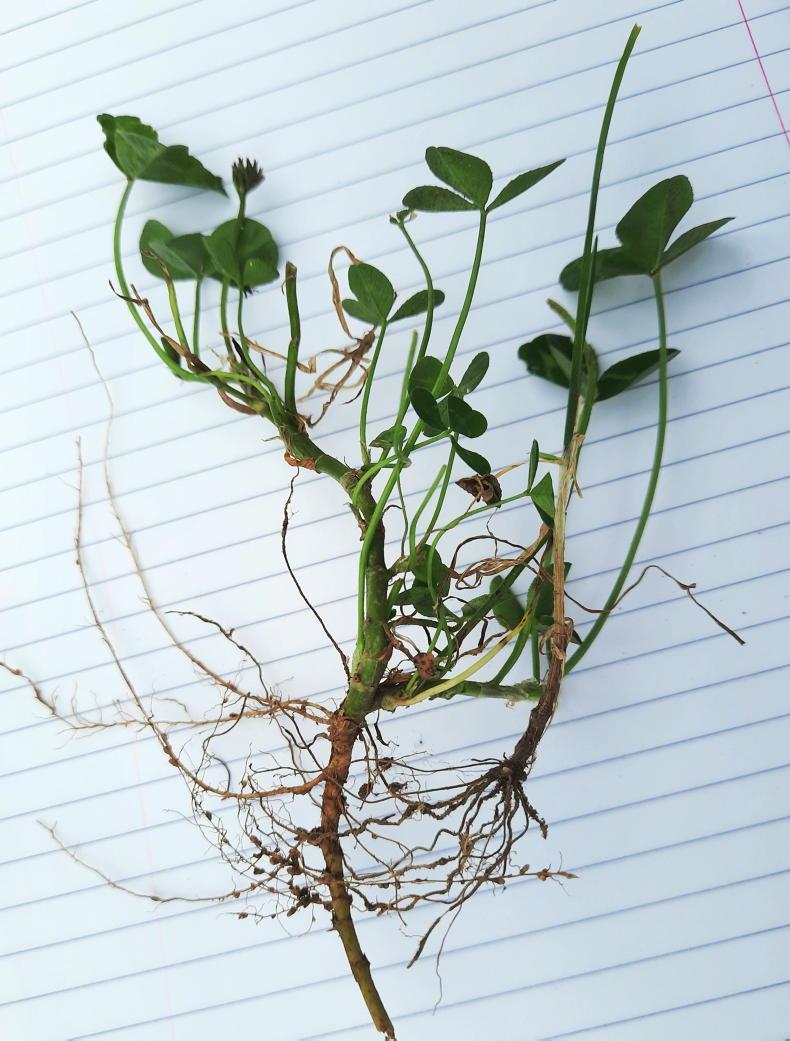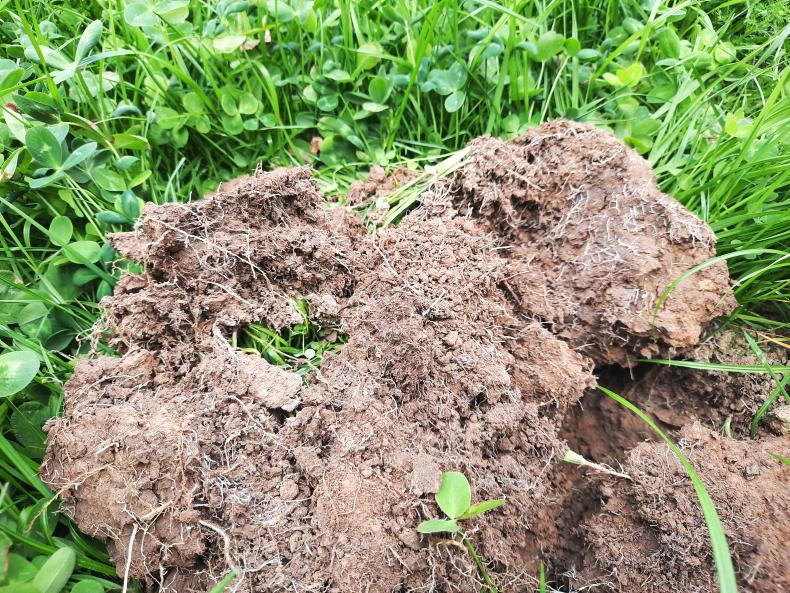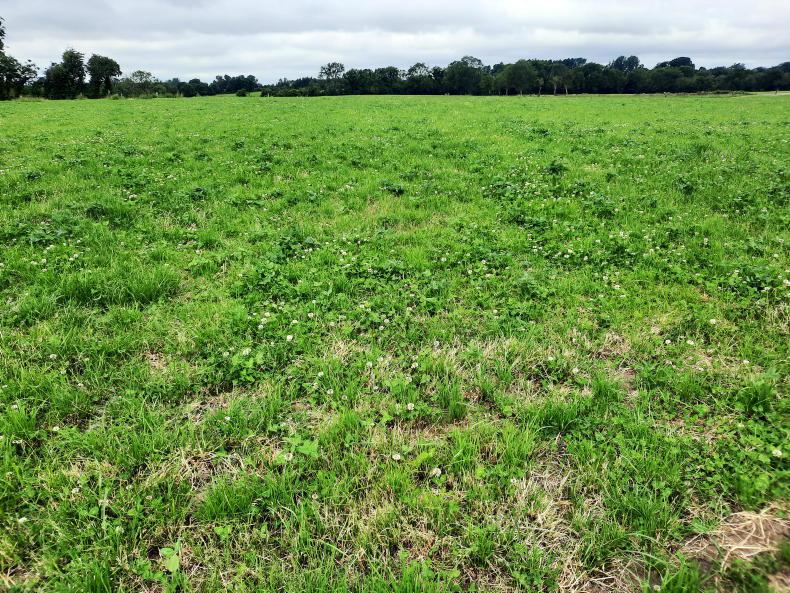In April and May we carried out clover distribution assessments on the Footprint Farms. These assessments stated how much clover was distributed across the sward and allowed farmers to make decisions based on the assessments.
If a sward has a clover distribution assessment of 0-40%, the advice is to treat with a high nitrogen application rate to meet targets or else it needs to be reseeded with clover. Swards with 40-70% distribution can be oversown with clover (in spring and early summer) and the advice for swards with 70% clover distribution or higher is to cut out nitrogen application entirely from about May onwards.

Nitrogen-fixing nodules on clover.
Cutting nitrogen completely is a big step to take, but clover’s job is to fix nitrogen and if artificial nitrogen is spread on these high-clover paddocks the clover may begin to leave the sward.
Solohead research farm
James Humphreys of Teagasc explained his method of assessing clover and how to manage the swards to the Irish Farmers Journal back in April and in June we travelled to Teagasc’s Solohead Research Farm for a Signpost farm walk to see the method working.
James showed results from trials on the farm from a high-nitrogen system with perennial ryegrass and a clover content of 10% receiving 275kg N/ha as well as a system with 22% clover content receiving 96kg N/ha in the form of protected urea and then a system receiving no artificial nitrogen with a clover content of 30%.

All three systems received the same amount of slurry in the year, while the system with no artificial nitrogen received watery slurry.
The high-nitrogen sward produced the most grass at 15.7t DM/ha. The swards receiving protected urea with 20% clover content produced 15.2t DM/ha and the swards receiving no nitrogen produced 15.1t DM/ha.
Clover content and clover distribution
It should be noted that the swards with 30% clover content have clover distribution percentages of 90-100%. Clover content and clover distribution are different. Clover content is the percentage of clover in the sward.
However, clover distribution is the spread of clover across the sward. To calculate the clover distribution percentage, walk across a paddock in diagonal lines or a “W” shape and throw a quadrat every 20m or so. If there is one stem of clover in the quadrat, that is marked as having clover.
If the quadrat is full of clover the next time it is thrown that spot is also marked as having clover. Calculate the percentage of quadrats with clover in them to get the distribution percentage.
If nitrogen is not applied to the sward then the place where there is one stem of clover has the opportunity to multiply and then the overall clover content can increase.
Cutting N use while maintaining profits
Cutting down on nitrogen use while maintaining production is something that all farmers need to try to do to cut costs and contribute to a reduction in emissions.

A scaled-up version of the trial showed the farm with zero artificial nitrogen was 60% more profitable.
James displayed figures from a scaled-up version of the trials already discussed to a farm of 50ha in size. The farm receiving no artificial nitrogen with a clover content of 30% was producing 15.1t DM/ha, had a stocking rate of 2.45 cows/ha and a net margin of €1,719/ha. This compared to a farm receiving 280kg N/ha with a clover content of 10%. This farm was producing 15.7t DM/ha, had a stocking rate of 2.56 cows/ha and a net margin of €1,071/ha. The farm with zero artificial nitrogen was 60% more profitable. It should be noted that the herd EBI was 195 on the zero N farm and 165 on the high N farm. Bloat is one thing that James also warned farmers need to be acutely aware of. A cow could go down with bloat 15 minutes after going out to grass. So management needs to be good on this.
Soil type and reseeds
The farm was extremely dry in June, but the soil type is a heavy gley and drainage is undertaken in some shape or form every year on the farm. Soil pH, phosphorus and potassium levels are all good on the farm and this is key when establishing clover.

Two bags of 10-10-20 per acre are generally applied to new reseeds and the clover will have nodules six weeks after sowing, giving it the ability to fix nitrogen.
Looking at new reseeds, James noted post-emergence spraying is essential and timely application is important when weeds like docks are about the size of a €2 coin.
That is clover’s job after all and if we are applying nitrogen the clover does not have a job to do. So in order to increase clover levels we need to reduce nitrogen application rates.
Away from the figures, it was marvellous to walk fields with 100% clover distribution.
From red to white clover, Solohead is a farm to be showcased. It shows what can be grown with very little nitrogen and is a reassurance for farmers to visit if they are planning to cut nitrogen usage on their farms.
This is something all farmers are going to have to do and dairy farmers are most dependent on high nitrogen rates. Walking across the farm shows the realities of what can be done. It is the future of farming and farmers need to hear more about it.
James said at one stage that nothing makes clover harder to manage than applying nitrogen. In order to believe this and make the changes you need to see it, and going to Solohead it is clear what can be done.
Walking across the paddocks, clover is in abundance and grass growth is strong and this is clear in the grass measurements.
In April and May we carried out clover distribution assessments on the Footprint Farms. These assessments stated how much clover was distributed across the sward and allowed farmers to make decisions based on the assessments.
If a sward has a clover distribution assessment of 0-40%, the advice is to treat with a high nitrogen application rate to meet targets or else it needs to be reseeded with clover. Swards with 40-70% distribution can be oversown with clover (in spring and early summer) and the advice for swards with 70% clover distribution or higher is to cut out nitrogen application entirely from about May onwards.

Nitrogen-fixing nodules on clover.
Cutting nitrogen completely is a big step to take, but clover’s job is to fix nitrogen and if artificial nitrogen is spread on these high-clover paddocks the clover may begin to leave the sward.
Solohead research farm
James Humphreys of Teagasc explained his method of assessing clover and how to manage the swards to the Irish Farmers Journal back in April and in June we travelled to Teagasc’s Solohead Research Farm for a Signpost farm walk to see the method working.
James showed results from trials on the farm from a high-nitrogen system with perennial ryegrass and a clover content of 10% receiving 275kg N/ha as well as a system with 22% clover content receiving 96kg N/ha in the form of protected urea and then a system receiving no artificial nitrogen with a clover content of 30%.

All three systems received the same amount of slurry in the year, while the system with no artificial nitrogen received watery slurry.
The high-nitrogen sward produced the most grass at 15.7t DM/ha. The swards receiving protected urea with 20% clover content produced 15.2t DM/ha and the swards receiving no nitrogen produced 15.1t DM/ha.
Clover content and clover distribution
It should be noted that the swards with 30% clover content have clover distribution percentages of 90-100%. Clover content and clover distribution are different. Clover content is the percentage of clover in the sward.
However, clover distribution is the spread of clover across the sward. To calculate the clover distribution percentage, walk across a paddock in diagonal lines or a “W” shape and throw a quadrat every 20m or so. If there is one stem of clover in the quadrat, that is marked as having clover.
If the quadrat is full of clover the next time it is thrown that spot is also marked as having clover. Calculate the percentage of quadrats with clover in them to get the distribution percentage.
If nitrogen is not applied to the sward then the place where there is one stem of clover has the opportunity to multiply and then the overall clover content can increase.
Cutting N use while maintaining profits
Cutting down on nitrogen use while maintaining production is something that all farmers need to try to do to cut costs and contribute to a reduction in emissions.

A scaled-up version of the trial showed the farm with zero artificial nitrogen was 60% more profitable.
James displayed figures from a scaled-up version of the trials already discussed to a farm of 50ha in size. The farm receiving no artificial nitrogen with a clover content of 30% was producing 15.1t DM/ha, had a stocking rate of 2.45 cows/ha and a net margin of €1,719/ha. This compared to a farm receiving 280kg N/ha with a clover content of 10%. This farm was producing 15.7t DM/ha, had a stocking rate of 2.56 cows/ha and a net margin of €1,071/ha. The farm with zero artificial nitrogen was 60% more profitable. It should be noted that the herd EBI was 195 on the zero N farm and 165 on the high N farm. Bloat is one thing that James also warned farmers need to be acutely aware of. A cow could go down with bloat 15 minutes after going out to grass. So management needs to be good on this.
Soil type and reseeds
The farm was extremely dry in June, but the soil type is a heavy gley and drainage is undertaken in some shape or form every year on the farm. Soil pH, phosphorus and potassium levels are all good on the farm and this is key when establishing clover.

Two bags of 10-10-20 per acre are generally applied to new reseeds and the clover will have nodules six weeks after sowing, giving it the ability to fix nitrogen.
Looking at new reseeds, James noted post-emergence spraying is essential and timely application is important when weeds like docks are about the size of a €2 coin.
That is clover’s job after all and if we are applying nitrogen the clover does not have a job to do. So in order to increase clover levels we need to reduce nitrogen application rates.
Away from the figures, it was marvellous to walk fields with 100% clover distribution.
From red to white clover, Solohead is a farm to be showcased. It shows what can be grown with very little nitrogen and is a reassurance for farmers to visit if they are planning to cut nitrogen usage on their farms.
This is something all farmers are going to have to do and dairy farmers are most dependent on high nitrogen rates. Walking across the farm shows the realities of what can be done. It is the future of farming and farmers need to hear more about it.
James said at one stage that nothing makes clover harder to manage than applying nitrogen. In order to believe this and make the changes you need to see it, and going to Solohead it is clear what can be done.
Walking across the paddocks, clover is in abundance and grass growth is strong and this is clear in the grass measurements.










 This is a subscriber-only article
This is a subscriber-only article









SHARING OPTIONS: